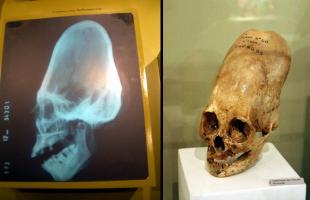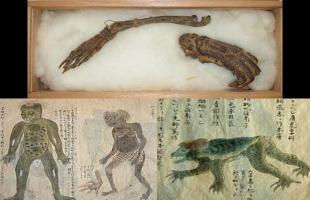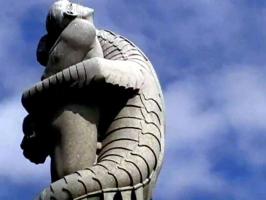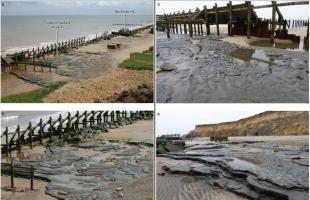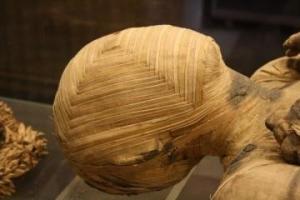Anomalous human remains

From the fossils of Homo sapiens that are supposedly millions of years old, to not-even-human fossils, wild claims have been made on the basis of some really poor evidence. This sub-section looks at some of the best known examples.
The Oldoway man
In 1913, Professor Hans Reck (1886-1937) of the Humboldt-Universität zu Berlin (Humboldt University of Berlin, at the time known as Universität unter den Linden) discovered an anatomically modern human skeleton at Olduvai Gorge in what was then German East Africa and is now Tanzania. The skeletal remains, including a complete skull, had to be removed from the highly cemented deposit in which they were contained with hammers and chisels, leading Reck to conclude that the remains were of high antiquity.

He believed that the deposits above the skeleton were undisturbed, but the contracted position of the skeleton and its completeness are very different from the usual condition of hominid fossils, which tend to be of body parts rather than complete skeletons. It was partly thanks to the controversy surrounding this discovery that the young Louis Leakey (1903-1972) became fascinated with the Olduvai Gorge site. Reck’s skeleton was notorious because its age could not be established satisfactorily. As Reck could not return to the site (he was German and the United Kingdom had acquired Germany’s African colonies as a result of the 1919 Treaty of Versailles), Leakey began his lifetime’s work there.
The difficulty with accepting Reck’s skeleton as being a million years old (as some creationists have claimed) is that his work was done without any appreciation of archaeological stratigraphy. Although the deposit from which the skeleton was recovered was of that sort of age, it was not clear to Reck if the burial was intrusive (in other words, deposited more recently by digging a grave into that particular geological stratum). Indeed, geological analysis of the material surrounding the skeleton showed it to contain red pebbles and limestone chips derived from higher (i.e. later) strata than that in which the skeleton was thought to have lain. This makes it certain that it was intrusive, in other words, in a grave cut down from a higher layer. As early as 1932, Leakey’s work there showed that this has to be the most economical explanation; had there been anatomically modern humans at this date in the gorge, we would expect to find other remains in contemporary strata, and as we do not, we must question Reck’s original judgement. In fact, even Reck later came to agree that the skeleton was of a recently buried human (most estimates now put it at around 20,000 years old).
A skull from Buenos Aires
Workers excavating a dry dock in Buenos Aires (Argentina) in 1896 found a human skull, allegedly in a Pre-Ensenadan stratum, a deposit dated one to one and a half million years old, eleven metres below the level of the Rio de la Plata.

The Argentine palaeontologist Florentino Ameghino (1854-1911) gave it the scientific name Diprothomo platensis; however, re-examination by the American anthropologist Aleš Hrdlička (1869-1943) a short time later found the cranial capacity to be within the range of modern Homo sapiens and he rejected the new species. There are two problems with the discovery if we follow the conventional view: anatomically modern humans did not exist a million years ago and there were no humans in the Americas before about 35,000 years ago (to accept a controversially early date for their arrival in the western hemisphere).
As with Reck’s skull in Tanzania, there is no indication that the skull fragment was actually embedded in an undisturbed geological deposit. Moreover, I have been unable to find out anything about the skull beyond what appears on creationist websites and in Forbidden Archeology. Presumably, it has been consigned to the dustbin of history, where it remains an exhibit to the errors of previous generations of palaeoanthropologists.
A shot ‘Neanderthal’?
A number of books and internet sites make the claim that The British Museum (Natural History) in London holds the skull of a Neanderthal, dated 38,000 years old and excavated in 1921 at Kabwe in what is now Zambia. The left side of the skull displays a circular hole about 8 mm in diameter. None of the radial split-lines that would have been left had the hole been made by a cold projectile, such as a spear, are visible around the hole. On the opposite side of the skull, the parietal bone is shattered, as if skull was blown up from inside. Two solutions have been proposed: either the skull is from something that lived in recent centuries and was shot by a European, or there were rifles in Palaeolithic Africa.

Virtually nothing is correct in these claims. The Kabwe skull (often known as ‘Broken Hill Man’ after the name of a nearby town) is older than the claim, at 125,000 to 300,000 years old, and it was found on 17 June 1921 by a Swiss miner, Tom Zwiglaar, in a limestone cave. It was the first early human fossil to be found in Africa and was sent to Arthur Smith Woodward (1864-1944), who gave it the new species name Homo rhodesiensis (Rhodesian Man). More recent anthropologists have preferred to see it as a primitive form of Homo sapiens, but are undecided on the precise species. It may be related to Homo heidelbergensis, the ancestor of the predominantly European Neanderthals (there were never any Neanderthals in Africa) or it may indeed be a separate species, Homo rhodesiensis, as Arthur Smith Woodward originally proposed, which would be our direct ancestor.
So much for the species and the date. What about the “bullet hole”? Well, for one thing, it did not kill the individual. The edges of the lesion have started to heal, so whatever caused the hole was not the cause of death. Instead, the wound appears to have been a pathological, rather than a traumatic lesion, caused by an infection in the soft tissue over it. Few individuals survive a bullet to the brain; needless to say, the parietal bone on the opposite side is not shattered, as is claimed, but is very much intact. The individual may thus have died from a pathological condition, perhaps an abscess or ulcer that had become septic.
The Castenedolo skull
In the late summer of 1860, Professor Giuseppe Ragazzoni (1824-1898), a prominent geologist from the Istituto Techniche di Brescia (Brescia Technical Institute), was collecting fossil shells from Pliocene deposits at the base of a low hill called Colle di Vento at Castenedolo, about 10 km south-east of Brescia. There, he found an anatomically modern human skull, supposedly in a formation dating from the Astian stage of the Middle Pliocene, about three to four million years old. It had coral cemented onto it with blue clay. Nearby, he found bones belonging to the thorax and limbs.

Like so many of these nineteenth-century discoveries, the exact circumstances of the find are unclear; the most likely explanation is that the skull belonged to a relatively recent (and probably post-glacial) burial cut through this deposit. The archaeological applications of stratigraphy were not understood at this time, so a geologist working on Pliocene deposits would naturally assume that all bones and fossils from this stratum were contemporary with its formation. Although the anatomist Giuseppe Sergi (1841-1936) visited the site in 1883 and was unable to identify a grave cut, a skeleton was found at the site in 1889, when Sergi was able to confirm that it did indeed lie in a grave. A radiocarbon date obtained on the ribs in 1969 confirmed the recent date of the skull, with a determination of 958±116 bp (847-1271 Cal AD; BM-496); the presence of a second skeleton in a grave makes it likely that Ragazzoni had unknowingly stumbled upon a forgotten medieval cemetery.
A human jaw from Foxhall
In 1855, the jawbone of an anatomically modern human was discovered by workmen digging for coprolites in the Pliocene Red Crag deposits at Foxhall (Suffolk, UK). The bone was not recognised in situ, but was found amongst coprolites when delivered to a Mr Packard’s manure factory. It was sold by one of the men to the local pharmacist, John Taylor, who gave it to Sir Thomas Beaver less than three months later. In March 1857, Sir Thomas passed it to Dr Robert Hanham Collyer (1814-1891), a physician originally from Jersey but who had emigrated to Philadephia with his parents in 1836, who was intrigued by the discovery of a human fossil of such apparently early date.

Collyer exhibited the specimen to the Ethnological Society of London in April 1863; its members seem not to have agreed on its status, George Busk regarding it as most likely from a Roman woman and Thomas Henry Huxley, who examined it at leisure the next day, agreed that it did not have the characteristics of fossilised bones from the Red Crag deposits. Collyer’s published drawing of the jaw shows its modern morphology clearly. Interest in the bone waned and its whereabouts was no longer known by 1930. The obvious explanation – that this was a relatively recent bone from a burial that had been cut into Pliocene deposits – is found wanting by Cremo & Thompson for no better reasons than that some genuinely ancient fossil hominid remains had equally poorly validated provenances and some have disappeared. This is an argument based on false analogy.
A child’s jaw in coal?

A jawbone, found at a depth of 183 m (600 feet) in a Tuscan coal mine, was identified by Dr Johannes Hürzeler of the Museum of Natural History in Basel (Switzerland) in 1958. It was badly distorted through its burial in the coal, but was sufficiently identifiable to enable it to be given an age at death of between five and seven. A number of biologists suggested that it belonged to a human ancestor, Hürzeler going so far as to claim it as “the world’s oldest man”, but this claim was not accepted by the overwhelming majority of palaeoanthropologists. It is now largely ignored as a potential ancestor. Creationists have taken this to mean that it was fully human, claiming it to be of modern morphology. This is nonsense: it belongs to a fossil primate, Oreopithecus bamboli, which flourished during the Miocene period, around twenty million years ago.
The ‘Beartooth Highway molar’

During the construction of the Beartooth Highway (Montana, USA), a supposedly fossilised tooth was found in an Eocene deposit in Number 3 shaft of the Eagle Mutual Coal Mine of Bear Creek, 88 km southwest of Billings (Montana, USA), in November 1926. The mining company doctor, J C Fred Siegfriedt (died 1940), also mayor of Bearcreek and later of Red Lodge, declared it to be a human tooth.
Siegfriedt believed that the enamel had been replaced by carbon and the roots by iron, a very strange sounding fossil! The first published account, in The Carbon County News of 11 November 1926, claims that Siegfriedt had asked several dentists to identify a mould created from the fossil, which they recognised as a human second lower left molar. The article was accompanied by a photograph, reproduced here. It is unfortunate that there is no scale provided, but there is an indication of its size from a slightly later report: according to a Dr E E Free, writing in The Literary Digest of 18 December 1926,
“It is about the size of a human tooth, being about one-third inch from the top of the crown to the tips of the roots. This is slightly smaller than the average of modern human teeth, but not so small as to make human origin impossible. The crown of the tooth is relatively low in comparison with the length of the roots, but this also is not inconceivable in a human tooth. Four cusps project from the crown; which is also an appearance found in some human molars, the fifth cusp which is theoretically present being sometimes so reduced in size as to be invisible. The roots are intact and are of the same general shape as those of human teeth. The entire tooth is partially carbonized and impregnated with iron sulfid, as a result of its long burial in the coal-beds where it was found.”
Siegfriedt was unable to persuade any palaeontologists that he had really discovered a fossil. In a letter of 12 January 1927, he expressed his frustration in terms that make clear his motivation:
“I was simply bringing my discovery to the public notice and from the attitude that was hurled at me, one would think I was trying to hold up a bank. However I have the tooth and the most beautiful specimen at that. Since my discovery I find several gaps in the Geologic Time Table, which have not satisfactorily been explained.”
From this letter, we can guess that Siegfried was what we would now term a Young Earth Creationist, who was keen to dispute evolution and geological assessments of the age of the earth. The supposed fossil is not a human molar, but a simulacrum, a natural object resembling something meaningful to human beings.









